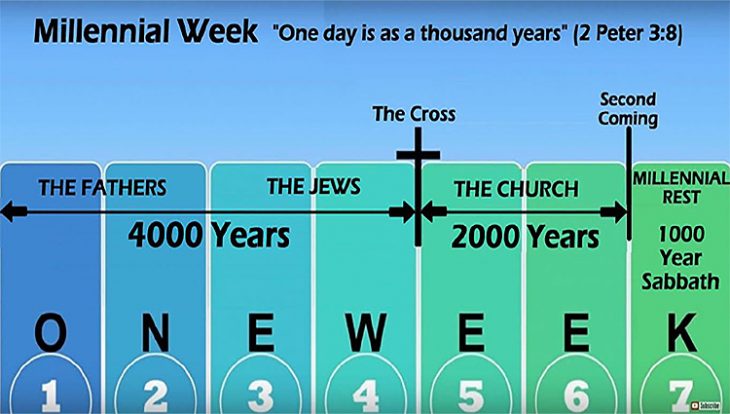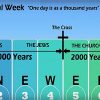The Scriptures contain an implied prophecy that strongly suggests that we are the terminal generation — the one that will experience the Rapture of the Church.
But before we take a look at it, let’s consider a fact that most Christians seem unaware of. Did you know that there is a prophecy in the Old Testament that clearly establishes the season of the Lord’s First Coming? It is found in the book of Daniel in chapter 9, beginning with verse 24. It is usually referred to as the “Prophecy of the 70 Weeks of Years.”
Daniel’s Designation for the Coming of the Messiah
The name of the prophecy comes from the fact that Daniel prophesies that certain events will occur among the Jewish people over a period of 490 years, or 70 weeks of years. He states very clearly that the Messiah will come before the end of 483 of these years. The question, then, that immediately emerges is, “What is the starting point for the countdown of these years?” Daniel says the countdown will begin with “the issuing of a decree to restore and rebuild Jerusalem” (Daniel 9:25).
After the Babylonian Empire was overthrown by the Medes and the Persians, three Persian kings issued edicts regarding the return of the Jews to their homeland. The first came in 538 BC, when Cyrus authorized Zerubbabel to rebuild the Temple in Jerusalem (Ezra 1:1-3). The second, issued by Artaxerxes in 457 BC, gave Ezra permission to reinstitute the Temple services, appoint judges and teach the Law (Ezra 7: 11-26). In 445 BC, Artaxerxes issued a decree for Nehemiah to rebuild the city of Jerusalem and its walls (Nehemiah 2:1-8).
On the surface, the third decree, the one issued to Nehemiah, seems to be the most obvious candidate for the starting date of the prophecy, for it is the only one that specifically relates to the rebuilding of the city. For that reason, most commentators have selected it as the beginning of the 70 weeks of years.
Using 445 BC as the starting point, experts on biblical chronology have concluded that the terminal point of the 483 years would be 27 AD at the earliest and 33 AD at the latest. The differences depend on whether you calculate using solar years or 360-day lunar years.
The point, of course, is that Jesus was born around 4 to 6 BC, and thus His arrival fits the prophecy since His birth occurred before the latest possible terminal point of the prophecy. And this fact presents a major problem to the Jews since they deny Jesus was the Messiah. If He was not, then how can they explain that the Messiah was not born within Daniel’s time period? After all, they recognize Daniel as a legitimate prophet of God.
The major point I want to make is that Daniel’s prophecy clearly revealed the season of the Lord’s First Coming. And, in like manner, there are prophecies in both the Old and New Testaments that reveal the season of the Lord’s Second Coming — not the date, but the general season. And it is my contention that those prophecies point to our day and time, and thus we are the terminal generation.
An Implied Prophecy
One of the most important of those prophecies is one that is implied in the Genesis account of Creation, as found in Genesis chapter 2:
1) Thus the heavens and the earth were completed, and all their hosts.
2) By the seventh day, God completed His work which He had done, and He rested on the seventh day from all His work…
The Creation account, which consists of six days of labor followed by one day of rest is God’s template for the time that is repeated over and over throughout the Scriptures. Consider the evidence below:
1) The Week of Days — Six days of labor followed by a Sabbath of rest.
2) The Week of Weeks — Seven weeks or forty-nine days between Passover and the Feast of Pentecost, concluding with a Sabbath day of rest.
3) The Week of Months — The seven months containing the seven feasts of Israel, beginning with Passover in the Spring and concluding with the Feast of Tabernacles in the Fall, which is a celebration of rest from the agricultural labors of the year.
4) The Week of Years — Seven years followed by a Sabbath year, when the land is allowed to rest from cultivation.
5) The Week of Weeks of Years — Forty-nine years leading up to the celebration in the 50th year of the Jubilee, and that year is to be a year of rest.
6) The Week of Millenniums — The idea that 6,000 years of human labor and strife will be followed by 1,000 years of rest during the Millennial Reign of the Messiah.
The last example of the week template that is mentioned above is the theme of this article. It is a concept that some Jews and Christians have agreed upon for the past two thousand years.
A Possible Pre-Jewish Example
In fact, there is evidence that the concept pre-dates the founding of the Jewish people with the call of Abraham. References to the 7,000-year theory can be found in writings attributed to Enoch who lived in the seventh generation from Adam and was Noah’s grandfather. Portions of at least ten quotes from the Book of Enoch were found in the Dead Sea Scrolls.
These writing are not canonical, but there is a quotation from them in the New Testament book of Jude (verses 14-15). It describes the Second Coming of the Messiah, pointing out that according to Enoch, the Messiah will one day come in judgment to pour out the wrath of God on “ungodly sinners.”
We know from non-biblical sources that the Second Book of Enoch stated that there would be 7000 years of history and that the beginning of the 8,000th year would mark the start of the Eternal State (2 Enoch 33:1).1
Whether these writings date from the time of Enoch or were written later by someone using his name, they indicate that the idea of 7,000 years of human history on this earth is a very old tradition.
Jewish Examples
The oldest existing Jewish reference to the Week of Millenniums is probably the one found in the Talmud which references a statement attributed to the prophetic school established by the prophet Elijah:
Six thousand years is the duration of the world. Two thousand of the six thousand years are characterized by chaos; two thousand years are characterized by Torah, from the era of the Patriarchs until the end of the Mishnaic period; and two thousand years are the period of the coming of the Messiah (Sanhedrin 97a).
This concept is echoed in a 10th Century AD midrash called Tanna D’vei Eliyahu. (A midrash is commentary on part of the Hebrew scriptures.) It reads as follows:2
The world is to exist 6,000 years. In the first 2,000, there was desolation (no Torah, from Adam to Abraham), 2,000 years the Torah flourished, and the next 2,000 years is the Messianic era (He should have come at the beginning of the last 2,000 years; the delay is due to our sins).
Of course, the Messiah did come at the beginning of the last 2,000 years, but He was not recognized by the Jewish people.
This concept of 6,000 years of human toil and conflict followed by 1,000 years of rest is still alive among Jewish rabbis and is being taught by them. Take, for example, Rabbi Baruch S. Davidson, of Brooklyn, NY who is a writer for Chabad, an Orthodox Jewish Hasidic movement. When asked about the 7,000 year theory, he replied:3
The Talmud tells us that this world, as we know it, will last for six thousand years, with the seventh millennium ushering in the cosmic Sabbath, the Messianic Era. Six days a week we work, and on the Sabbath we rest and enjoy the fruits of our labor; the same is true with millenniums.
The widespread acceptance of the 7,000-year concept among Jewish sages today is illustrated by the fact that the idea is accepted “across the Ashkenazi-Sephardi divide, the Hasidim-Misnagdim divide, and across the rational Talmud and mystical Kabbalah perspectives.”4
In the second part of our look at the prophecy of the Week of Millenniums, the Church’s historical writings will way into the prophecy.
References
1) William F. Dankenbring, “Six Thousand Years and Beyond,” (www.triumphpro.com/6000-year-plan.htm), pages 11-12.
2) Jim Bramlett, “Christ’s Soon Return: The Overwhelming Evidence,” (http://choicesforliving.com/spirit/part3/christreturn.htm), page 4.
3) Dankenbring, pages 8-9.
4) Craig Crawford, “The 7th Day Prophecy: A 6,000 Year Climax,” (www.theprophecies.com/year-20xx-the-7th-day), page 11.








Good Bible taught here.
I am 92 and I have been working on a Chronological Bible since I retire for Civil Service in Jan 1995 which I would like to give to you.